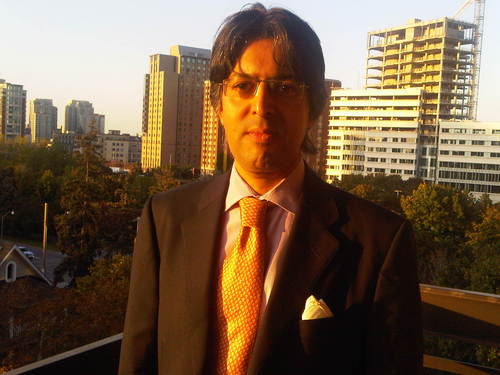 Author Vivek Kaul tells Sanjitha Rao Chaini that his book ‘Easy Money’ is an outcome of how money and the financial system have evolved over a very long period of time.
Author Vivek Kaul tells Sanjitha Rao Chaini that his book ‘Easy Money’ is an outcome of how money and the financial system have evolved over a very long period of time.
Why this book? How did the idea of writing this book come to you?
The book was essentially an evolution of the writing that I do to make a living. I first started writing on the financial crisis after the investment bank Lehman Brothers went bust. The idea was to explain to the readers what is happening in the world. The Indian media (or even the world media) at that point of time had turned into a jargon spewing monster. Terms like sub-prime, securitization, Alt-A, CDOs etc were being bandied around. So, I started writing a series of pieces explaining these terms and the impact they were having on the world at large.
Over a period of time I came to the realization that what is happening now is not just because of things that have happened over the last few years or even decades. It is an outcome of how money and the financial system have evolved over a very long period of time. It has all come together to cause the current financial crisis. Easy Money was an outcome of that realization.
What kind of research did you put into this book?
The research has been extensive. Even before I decided to write the book I had read some 75-80 books on money and the financial system as they had evolved. As I wrote, I read a lot of research papers and historical documents that were written over the past 300 years. These research papers were a storehouse of information. Interestingly, with the advent of the internet a lot of historical material is available at the click of a button. What also helped was the fact that websites like Infibeam.com source second hand books, which are not easily available otherwise, from the United States. I don’t think I would have managed to write the book that I have, 10 years back, sitting in Mumbai. I would have probably managed to do if I had access to a library at a good American university.
You write… “as we have seen throughout history money printing has never ended well. But the same mistake continues to be made.” Why do you think that we haven’t learnt the lesson?
I wish I had an answer for that. I can only make a guess. In every era people who make economic decisions feel that “this time it’s different”. The tragedy is that it is never really different. And hence, the lessons are never really learnt. The same mistakes are made. Money printing never ends well that is a something that the world refuses to learn.
Do you think we would have been better off in any way if we had stuck to the gold standard as a store of value of money?
When I started writing Easy Money , in late 2011, I thought that the gold standard is the answer. During the process of writing the book that idea evolved. The thing with the gold standard is that it limits the amount of money that can be put into the financial system. Ultimately, it becomes a function of the amount of gold being dug up from the earth and that is what makes it work as well. But this is something that no politician is comfortable with. And politicians are essential for democracy.
In fact, I spoke to Russell Napier, a financial historian who works for CLSA, sometime in 2012. And he made a very important point which changed my thinking on the gold standard. “The history of the paper currency system or the fiat currency system is really the history of democracy,” he told me during the conversation. “Within the metal currency there was very limited ability for the elected governments to manipulate that currency. And I know this is why people with savings and people with money like the gold standard. They like it because it reduces the ability of politicians to play around with the quantity of money. But we have to remember that most people don’t have savings. They don’t have capital. And that’s why we got the paper currency in the first place. It was to allow the democracies. Democracy will always turn towards paper currency and unless you see the destruction of democracy in the developed world and I do not see that we will stay with paper currencies and not return to metallic currencies or metallic based currencies,” he added.
So, in a way, the choice is between democracy and the gold standard. In fact, the era of the classical gold standard which started in the 1870s and survived till around the time of the First World War, was an era of limited democracy even in most of what is now known as the developed world.
There are contrary views on usage of bitcoins. Recently RBI even said it has no plans to regulate Bitcoins. Do you see a hard-landing for bitcoins? Do you think that central bankers will be able to regulate, and if not, what are the concerns?
That is a very difficult question to answer. One school of thought is that the Federal Reserve regularly lends out its gold to bullion banks, so that they can short-sell it and ensure that the price of gold does not rise beyond a point. Whether they will be able to crack the bitcoin system as well, in the days to come, I really don’t know.
How can policymakers make use of this book?
Policy makers don’t need any books. They do what they feel like doing. Given that, I don’t think this book or any book can be of much help to them. As the German philosopher Georg Hegel once said “What experience and history teach is this —that nations and governments have never learned anything from history, or acted on principles deduced from it.” And why should this time be any different?
What are you reading at the moment?
I have this habit of reading multiple books at the same time. So I read a few pages, drop that book and move onto something else. This loop keeps repeating. Right now I am reading Alan S Blinder’s After the Music Stopped. Blinder is a professor of economics at the Princeton University. He was also the vice chairman of the Federal Reserve of United States, between 1994 and 1996, under Alan Greenspan. His book is by far the best book I have read on the current the financial crisis. Excellent research presented in very simple English.
I am also reading The Bankers’ New Clothes by Anant Admati and Martin Hellwig. The fundamental point they make in their book is that if we need to make the financial system safer, banks need to have much more capital on their books than they currently have. This is one of the points I make in Easy Money as well. As Walter Bagehot, the great editor of The Economist once said more than 100 years back, “the main source of profitableness of established banking is the smallness of requisite capital.” This is something that needs to be set right.
As far as fiction goes I am currently reading a Swedish thriller titled Never Screw Up by Jens Lapidus. It is a sequel to a book which was also titled Easy Money. Ruskin Bond’s Tales of Fosterganj has just arrived and that is what I am looking forward to reading next weekend.
E-books or paper format ?
Paper totally. And there is a practical reason for it. I keep making notes on the edges (horrible habit some might say) as I read. This is a great help when one wants to write something and needs to revisit a book. You don’t have to bang your head against the wall at that point of time, thinking, where did I read that? So this ‘bad’ habit ensures that research and reading happen at the same time.
When and where do you write? And what’s the hardest thing about being a writer?
Living in Mumbai means that one really does not have much choice about where to write. Also, having worked in extremely noisy newspaper offices, I can write almost anywhere. The place doesn’t really matter, as long as I have a computer and an internet connection.
Most of my writing happens between 11AM to 5PM. Having said that, some of my best writing has happened post midnight. The one time I hate writing is early in the morning between 7 to 10 AM.
I recently finished reading this book titled The Infatuations by the Spanish author Javier Marias. In this book Marias writes “You have to be slightly abnormal to sit down and work on something without being told to.” That is the toughest thing about being a writer. It needs a lot of self discipline and self motivation, knowing fully well that the money you make from your writing will most likely never compensate you for the opportunity cost that comes with it.
What next?
Easy Money is a trilogy. The first book ends around the time of the First World War. The second book starts from there and goes on till the time of the dot-com bubble burst. The third one deals with the current financial crisis. I have just finished the final edit of the second book, which should be out very soon. In about a week’s time I will get back to the third book. I had last looked at it in January 2013. So to give the readers a complete perspective the third book needs to be updated because a lot has happened in the last one year.
The interview originally appeared in the Business World



